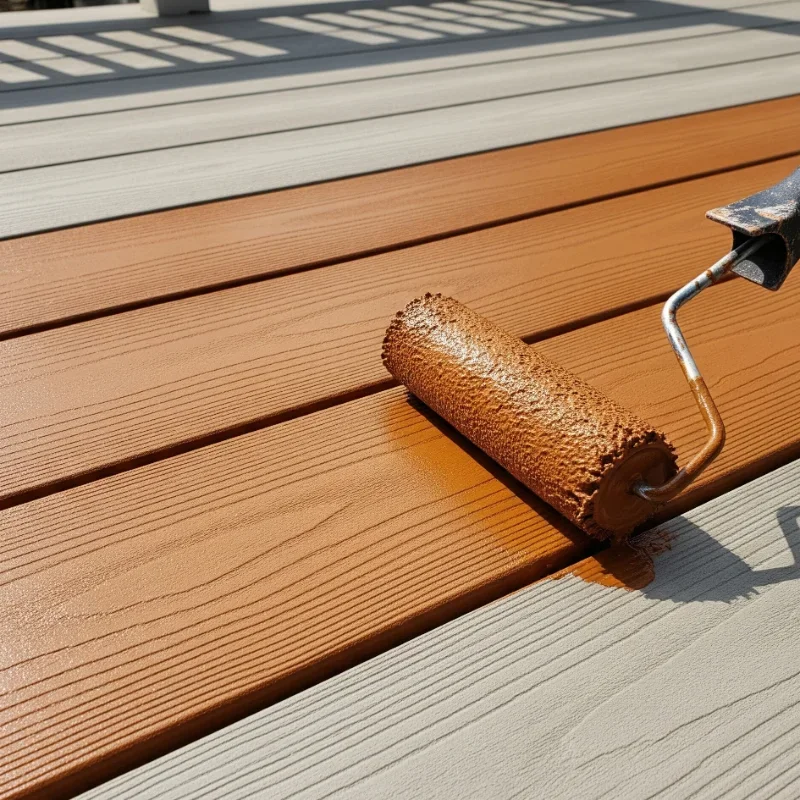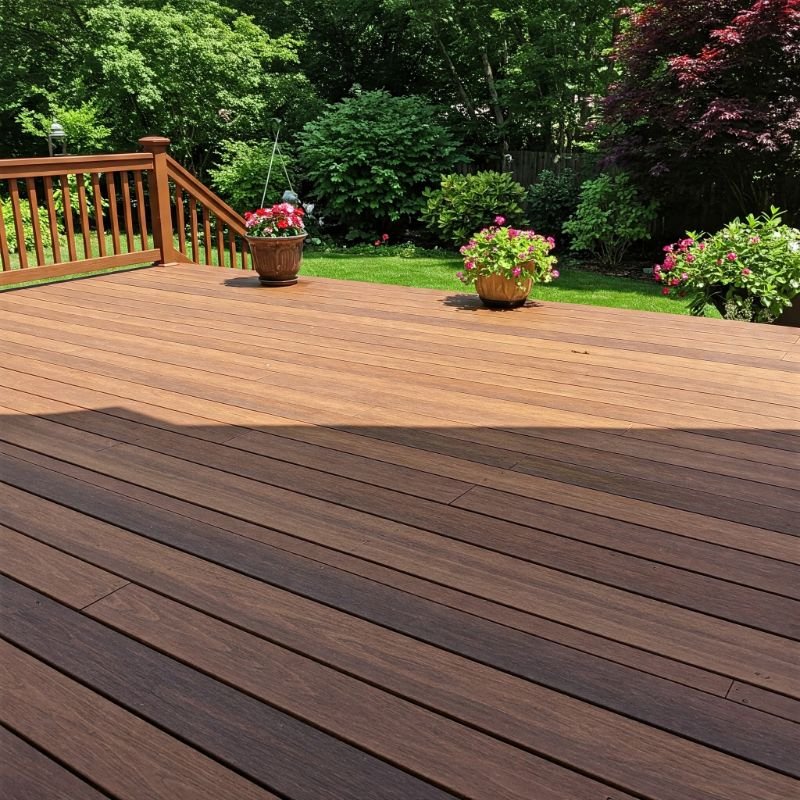Can You Paint Trex Decking? What to Know First
Wondering can you paint Trex decking? Learn what to know first, including pros, cons, and expert tips for painting composite decking safely.
So, you're staring at your Trex deck thinking it could use a color refresh, huh? Maybe that original shade isn't doing it for you anymore, or perhaps you've inherited a deck that clashes with your home's new paint job. Whatever the reason, you're probably wondering, "Can you paint Trex decking? What to know first before I grab that paintbrush?"
Well, hold your horses! Before you rush off to the hardware store, there's quite a bit you need to understand about painting composite decking. The short answer? Yes, you technically can paint Trex decking, but boy oh boy, there's a whole lot more to the story than that simple yes.
Having worked with countless homeowners facing this exact dilemma, I've seen the good, the bad, and the downright ugly when it comes to painted composite decks. Let's dive into everything you need to know before making this big decision!
Understanding Trex Decking: What You're Really Working With
The Composite Conundrum
First things first, Trex isn't your grandpa's wooden deck. This stuff is engineered composite material, typically made from a mix of recycled wood fibers and plastic. Pretty cool from an environmental standpoint, right? But here's the kicker: this unique composition makes painting it a whole different ballgame compared to traditional wood.
The surface of Trex decking is designed to resist pretty much everything Mother Nature throws at it. Rain, snow, UV rays, you name it! That same resistance that makes it so durable also makes it incredibly challenging for paint to stick properly. It's like trying to write on a non-stick pan with a regular pen!
Different Generations, Different Challenges
Not all Trex decking is created equal, folks. The company has evolved their products over the years, and what generation you have matters big time:
First Generation (Pre-2010): More porous, actually easier to paint but prone to mold and mildew
Second Generation (2010-2019): Added protective shell, much harder to paint
Current Generation: Enhanced shell technology, extremely paint-resistant
Knowing which generation you're dealing with? That's half the battle right there!
Can You Paint Trex Decking? What to Know First About Manufacturer Warnings
The Official Stance
Here's where things get interesting. Trex themselves generally advise against painting their decking products. Yep, you heard that right! They've spent millions developing finishes that shouldn't need painting, and they're pretty adamant about it.
Why the strong stance? Well, painting your Trex deck will absolutely void any warranty you might have left. Plus, they argue that their products are designed to age gracefully without additional coatings. But let's be real, sometimes "aging gracefully" isn't quite the look we're going for!
Legal and Warranty Implications
Looking at the fine print of your warranty? Painting is typically listed as a big no-no. Once you apply that first stroke of paint, you're essentially on your own if anything goes wrong. No more calling Trex for support if boards start warping or fading oddly.
But here's the thing: if your deck is already out of warranty, or if you're willing to accept the risk, then this becomes less of an issue. Just go in with your eyes wide open!
The Pros and Cons of Painting Composite Decking
The Bright Side of Painting
Despite all the warnings, there are some legitimate reasons why homeowners still choose to paint their Trex decking:
Complete color customization: Match your deck to any design scheme
Covering up stains or discoloration: Sometimes easier than deep cleaning
Refreshing an older deck: Bringing new life to worn surfaces
Increased UV protection: Quality paint can add another layer of defense
Cost-effective makeover: Cheaper than replacing the entire deck
The Not-So-Pretty Truth
Walking into this project with rose-colored glasses? Let me paint you the real picture:
Poor adhesion issues: Paint often peels or chips within a year or two
Maintenance nightmare: Once you paint, you're committed to repainting regularly
Slippery when wet: Many paints reduce the deck's slip resistance
Warranty voided: Kiss that manufacturer protection goodbye
Potential damage: Wrong products can actually harm the composite material
Preparation Steps: Can You Paint Trex Decking? What to Know First
Cleaning Like Your Life Depends on It
If you're still determined to paint, preparation is absolutely crucial. And I mean crucial! Start with the deepest clean your deck has ever seen:
Power wash thoroughly (but not too aggressively, around 1500 PSI max)
Use composite deck cleaner specifically designed for Trex
Scrub stubborn stains with a soft-bristle brush
Let it dry completely for at least 48 hours in good weather
Check for any repairs needed before proceeding
The Sanding Debate
Here's where opinions get divided faster than relatives at Thanksgiving dinner! Some pros swear by lightly sanding Trex to create better paint adhesion. Others warn it can damage the protective shell and make things worse.
If you do decide to sand:
Use fine-grit sandpaper (220 grit or higher)
Work gently in circular motions
Focus on glossy areas that need roughening
Clean thoroughly afterward to remove all dust
Priming: Your New Best Friend
Skipping primer on Trex decking? That's like going swimming without sunscreen in July! You absolutely need a high-quality bonding primer designed for plastic or composite surfaces. This isn't the place to cheap out, trust me.
Look for primers that specifically mention:
Adhesion to plastic surfaces
Exterior durability
Flexibility to handle temperature changes
Mold and mildew resistance
Choosing the Right Paint Products
Paint Types That Actually Work
Not all paints are created equal when it comes to composite decking. After seeing countless failed attempts, here's what actually has a fighting chance:
Acrylic latex paints designed for exterior use tend to perform best. They're flexible enough to handle the expansion and contraction of composite materials. Look for paints with these characteristics:
100% acrylic formula
Designed for floors or high-traffic areas
Self-priming varieties (though still use primer!)
Anti-slip additives available
UV-resistant properties
Solid color stains made for composite materials are another option. While technically not paint, they can provide color change with slightly better adhesion than traditional paint.
Products to Avoid Like the Plague
Whatever you do, steer clear of:
Oil-based paints (too rigid, will crack)
Interior paints (won't survive outdoors)
Cheap exterior paints (false economy, trust me)
Spray paint (uneven coverage, poor adhesion)
Deck stains meant for wood (won't penetrate composite)
The Application Process: Step-by-Step Guide
Getting Down to Business
Alright, you've prepped, you've got your supplies, and you're ready to transform that deck! Here's how to do it right:
Check the weather forecast: You need at least 48 hours of dry weather, ideally with temperatures between 50-85°F
Tape off areas: Protect siding, railings, and anything you don't want painted
Apply primer: Use a high-quality brush or roller, working in manageable sections. Don't puddle it on; thin, even coats work best
Let primer cure: Follow manufacturer instructions, usually 24-48 hours
First paint coat: Apply thin, even strokes following the board direction
Dry time is crucial: Rush this and you'll regret it later
Second coat: Most jobs need at least two coats for proper coverage
Final cure: Wait at least 72 hours before regular foot traffic
Pro Tips from the Trenches
Having watched both successes and disasters, here are insider tips that make all the difference:
Work in sections to maintain a wet edge
Don't paint in direct sunlight if possible
Use a small brush for gaps between boards
Add anti-slip additive to your final coat
Keep a wet rag handy for immediate cleanup of drips
Alternative Solutions to Consider
When Painting Isn't the Answer
Sometimes, the best solution isn't painting at all. Before committing to this project, consider these alternatives:
Deep cleaning and restoration might surprise you with how much it improves your deck's appearance. Professional-grade cleaners can remove years of buildup and restore significant color.
Deck tiles or covering systems can be installed over existing Trex decking. These interlocking tiles come in various materials and colors, providing a fresh look without paint.
Partial replacement of severely discolored boards might be more cost-effective than painting the entire deck.
Professional resurfacing services specialize in composite deck restoration using specialized coatings designed specifically for these materials.
The Nuclear Option: Full Replacement
I know, I know, nobody wants to hear this. But sometimes, if your Trex deck is really showing its age and painting seems like putting lipstick on a pig, replacement might be the smartest long-term investment. Newer Trex products come in amazing colors and finishes that might eliminate your desire to paint altogether!
Long-Term Maintenance and Expectations
The Repainting Cycle
Once you paint Trex decking, you're basically married to maintenance. Plan on:
Touch-ups annually in high-traffic areas
Full recoating every 2-3 years
Complete stripping and repainting every 5-7 years
Yeah, it's a commitment. That beautiful painted deck won't maintain itself!
Signs of Failure to Watch For
Keep an eagle eye out for these red flags:
Peeling or bubbling paint (moisture getting underneath)
Chalky or faded appearance (UV damage)
Cracks in the paint film (adhesion failure)
Slippery surfaces when wet (safety hazard)
Mold or mildew growth under paint (moisture trapped)
Cost Considerations and Budget Planning
The Real Numbers
Let's talk turkey about what this project actually costs:
DIY Approach:
Quality primer: $30-50 per gallon
Appropriate paint: $40-70 per gallon
Supplies and tools: $50-100
Your time: Priceless (or painful, depending on how it goes!)
Professional Job:
Typically $3-5 per square foot
Includes prep, materials, and labor
Often comes with a limited warranty
For a typical 300-square-foot deck, you're looking at $500-800 DIY or $900-1500 professionally done.
Hidden Costs Nobody Mentions
Don't forget about:
Ongoing maintenance products
Potential deck repairs discovered during prep
Tools you might need to buy or rent
The cost of fixing it if things go wrong
Conclusion
So, can you paint Trex decking? Technically yes, but it's definitely not a decision to make lightly. Understanding what you're getting into, properly preparing the surface, using the right products, and committing to ongoing maintenance are all crucial for any chance of success. While manufacturers don't recommend it and you'll void warranties, some homeowners find it worthwhile for that perfect color match. Just remember, once you start down this path, there's no easy way back to unpainted composite!
Read next: How to Clean Trex Decking Without Damaging It
Frequently Asked Questions
Q1: Will painting my Trex deck make it slippery?
A: Yes, most paints reduce traction unless anti-slip additives are mixed in.
Q2: How long does paint last on composite decking?
A: Typically 2-3 years before needing major touch-ups or full recoating.
Q3: Can I use regular deck stain on Trex?
A: No, wood stains won't penetrate composite materials and will fail quickly.
Q4: What happens if paint starts peeling?
A: You'll need to strip, sand, prime, and repaint the affected areas.
Q5: Is painting Trex decking worth the effort?
A: Only if you're committed to ongoing maintenance and accept warranty loss.







